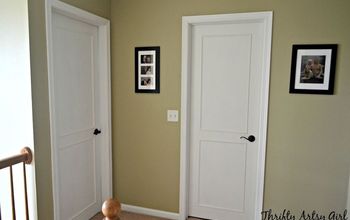How to Find a Stud in the Wall With and Without a Stud Finder

By Alexa Erickson
Hanging something up on the wall isn’t always as easy as hammering in a small nail and resting a frame on it. For heavy items, more attention to detail is required. Finding a wall stud is important for stability and safety, which we will explain why below.
Keep reading for everything you need to know about how to find a stud in the wall—with and without a stud finder—to anchor the object you want to hang.
Photo via Shutterstock
What Are Wall Studs?
A wall stud plays a fundamental role in a home’s frame-building. The stud is a vertical wood board that functions as a framing element in a building's wall. According to Lowe’s, wall studs are always spaced either 16 or 24 inches on-center (measured from the center of one stud to the center of an adjacent stud) along the wall and run between the floor and ceiling. Drywall or lath (for plaster walls) attaches to the edge of the studs via nails or screws.
A little more about wall-framing anatomy: The cavities between wall studs are called bays, and the horizontal pieces that run along the top and bottom of the wall are called the top and bottom plate.
Why Wall Studs Are Important
Wall studs serve an important role in hanging anything heavy. From large framed pictures and wall-mounted shelves to a large mirror and flat-screen TV, a stud provides something sturdy for a nail or screw to grip into and a heavy object to hang on.
Fasteners and hangers used to hang objects must be anchored in studs because the wall in and of itself isn’t strong enough to support the object’s weight. Studs step in for the rescue, holding the fasteners securely and preventing them from pulling out beneath the weight of the item you’re hanging.
Locating the center of the stud ensures the best support for the fasteners.
How to Find a Stud in the Wall With a Stud Finder
An electronic stud finder is an electronic handheld device that can locate framing studs behind walls by detecting changes in density behind a surface, a.k.a. a wooden stud behind drywall or a plaster wall.
There are also magnetic stud finders, which work by using magnets to sense nails or screws that have been driven into a stud. Magnetic stud finders aren’t always the most reliable to find studs, since they can sense any presence of metal behind a wall, even when it’s not a part of a stud. For that reason, we’ll teach you how to use an electronic stud finder to locate studs in your wall.
Tools and Materials Needed
- Electronic stud finder
- Tape measure
- Pencil
Step 1: Choose Where You Want To Hang the Item
The very first thing you should do is determine where on the wall you want to hang your item. The location and height will determine how you go about locating the stud. Mark off where the fastener (what you will use to hang the item, whether it’s a nail, picture hanger, hook, etc.) will sit on the wall with a pencil.
Step 2: Place the Stud Finder Near the Fastener
Turn on your stud finder and hold it flat against the wall near the fastener location you’ve marked with a pencil. Slowly slide the stud finder horizontally from left to right until the device alerts you (usually with a beep or light), that you’ve located one edge of the stud.
Step 3: Locate and Mark the Stud
Once you’ve located the first edge of the stud, mark it with a pencil. Then, move the stud finder horizontally away from this mark until the device alerts you that the second edge of the stud has been located. It should be 1 ½ inches from the first mark.
Step 4: Mark the Midpoint of the Stud
Measure and mark the midpoint between the two edges of the stud you have already marked. This location determines the center of the stud—the strongest point to hang from.
Step 5: Locate More Stud Points
To be absolutely certain you’ve located the stud, locate several more points on the suspected stud by moving your stud finder vertically up and down. If there the stud finder goes off at several points directly above and below your center stud point, it’s pretty safe to say that you’ve successfully located the stud.
Locate adjacent studs using the process outlined above.
How to Find a Stud in the Wall Without a Stud Finder
In a pinch with no stud finder on hand? There are still several methods that can be effective in finding studs. To confirm that what you’ve located is an actual stud before committing to hammering in your hanger or fastener, drive a thin finishing nail through the drywall near the baseboard. If it stops against something, you’ve likely located the stud!
Measure the Frame
The most reliable way of finding a stud without a stud finder is trusting the frame built behind the wall. “When a home is framed, the wall studs are usually spaced 16 or 24 inches apart,” explains the experts at Ace Hardware. If you start in a wall corner and measure out 16 inches and you don’t find a stud when testing a nail, keep measuring out and you should find one at 24 inches.
Use a Flashlight
You can also use a flashlight to search for the stud. Turn off all the lights in the room and point the flashlight down the wall at an angle. Locate where two pieces of drywall meet; there will be a noticeable seam. You should find a stud at this intersection.
Look at an Outlet
Outlets are usually nailed into studs. Find an outlet against the wall you’re working on, remove the cover, and investigate around the box. At least one side of the outlet will be visibly nailed into a stud. From there, break out the measuring tape to measure out left or right of the outlet at 16-inch and then 24-inch intervals if needed.
Use a Magnet
As we mentioned above, studs are attached to drywall and plaster walls via metal screws and nails. Try attaching a magnet (we recommend a strong one—that souvenir magnet on your fridge probably won’t work!) to a string and dragging it along your wall where you plan to hang your fastener. If the magnet is drawn to a spot on the wall, that is likely a stud. Test a small nail just to be sure.
Do you have tips for locating a stud in the wall? Share them below!
Enjoyed the project?
Comments
Join the conversation
-
 Dee
on Dec 26, 2021
Dee
on Dec 26, 2021
I just came across a Stud finder app for iOS and Android brings the simplicity and effectiveness of a real stud detector tool to your iPhone or Android device. The app uses your device's compass (magnetometer sensor) to pinpoint metal studs, nails, and screws embedded in all wood wall studs.
-
-

























Frequently asked questions
Have a question about this project?